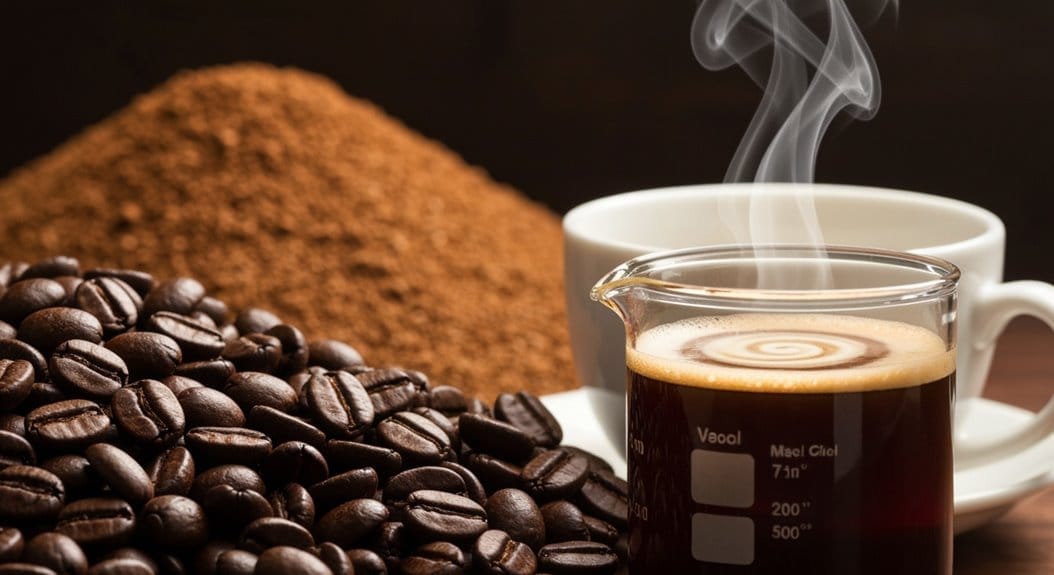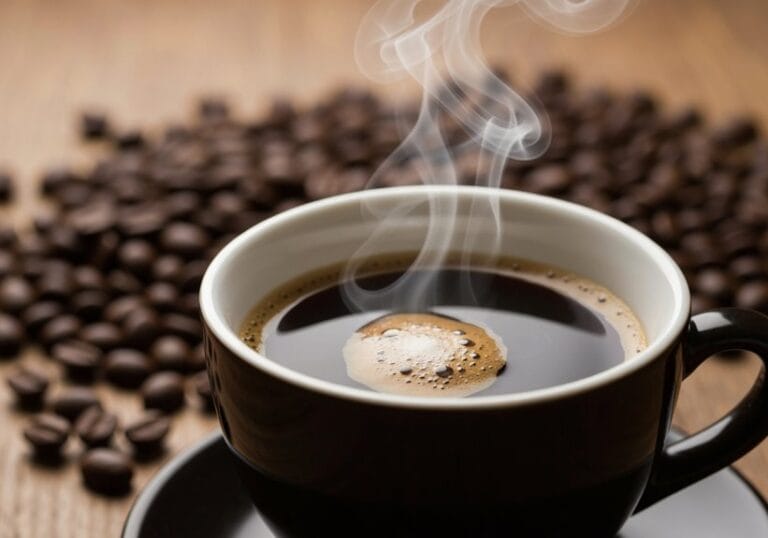So, here’s the deal: dark roast coffee isn’t automatically stronger, despite thinking it’s the superhero of brews with all that bold flavor! Surprisingly, caffeine remains pretty stable across roasts. Crazy, right? The dark beans might look tough, but they’re actually less dense, which can totally trip your taste buds! It’s all about how you brew it, folks! Stick around for more juicy details on caffeine content and espresso shenanigans—you won’t want to miss this!
Key Takeaways
- Dark roast coffee has a bolder flavor but does not contain more caffeine than light roast coffee by weight.
- Caffeine levels remain stable across all roast levels; roasting does not degrade caffeine content.
- Bean type matters; Robusta beans have nearly double the caffeine of Arabica beans, regardless of roast level.
- Brewing methods and extraction techniques play a significant role in caffeine yield, affecting perceived strength.
- The perception of strength in dark roasts may mislead consumers due to its intense flavor profile, not caffeine content.
Understanding Caffeine Content in Coffee
Regarding coffee, people often ask, “Which roast is stronger?” Well, let me tell you, the answer is a bit of a coffee conundrum!
So, here’s the scoop: despite the roast impact on flavor and aroma, caffeine stability means the total caffeine content stays pretty much the same between light and dark roasts. Yep, you read that right! Additionally, while the roasting process reduces bean weight, the actual caffeine molecules remain largely intact, ensuring they don’t disappear during roasting. In fact, the bean type plays a crucial role in determining the caffeine levels, with Robusta beans containing nearly double the caffeine compared to Arabica beans. Interestingly, brewing techniques also influence the caffeine yield, further complicating the question of which roast is stronger.
Those beans lose weight as they roast—thanks, evaporation—but the caffeine doesn’t really budge. Measuring by weight versus volume can trick you, though! A light roast scoop might pack more caffeine than a dark roast scoop, since dark beans are puffed up and fluffy (kind of like my post-holiday belly).
The Role of Roast Level in Caffeine Perception
Roast levels can be pretty confusing regarding how we perceive our morning cup of coffee. Ever notice how dark roast seems like it’s shouting, “I’m the strong one!”?
That’s just roast intensity playing tricks on our taste buds! Their bold flavor profiles can make you think you’ve chugged a shot of espresso, but hold up—those dark beans are actually less dense. Longer brewing times also allow more caffeine to dissolve due to increased contact.
It’s like they went to a coffee spa and lost some weight! So when we scoop, we get fewer beans, which means less caffeine.
But if you weigh them instead of scooping, surprise! The caffeine levels are pretty similar.
It’s a clever little magic show, really—smoky flavors fooling us into thinking we’re getting a caffeine kick! This biochemical transformation process during roasting also contributes to the overall flavor profile perceived in dark roasts.
Factors Influencing Caffeine Extraction

Caffeine extraction is like a brewing game—there are so many factors at play! From grind size to brewing time, each element dances together to create that perfect cup. Here’s a quick peek at what influences your caffeine kick:
| Factor | Impact on Caffeine Extraction |
|---|---|
| Grind Size | Finer grinds equal faster extraction |
| Brewing Time | Longer times enhance caffeine yield |
| Water Temperature | Hotter water extracts caffeine quicker |
| Bean Variety | Different beans mean different caffeine levels |
Comparing Caffeine Levels Across Brewing Methods
Now, here’s the kicker: even with dark roasts getting a caffeine enhancement from their unique composition, if you’re brewing light roast by weight, it typically wins in the caffeine race due to bean density. It’s like comparing a pillow fight to a sumo wrestling match—both fun, but one’s got more weight behind it! Interestingly, brewing methods can significantly influence caffeine extraction, leading to variability between drink types. For instance, espresso shots provide all the caffeine in an Americano, making the method of preparation crucial for understanding caffeine content.
Frequently Asked Questions
Does Dark Roast Coffee Have More Flavor Than Light Roast?
Dark roast coffee typically features a bolder flavor profile with an intense aroma compared to light roast. While its flavors are robust, they are generally simpler, lacking the complexity found in lighter varieties.
Can the Caffeine Content Affect Sleep Quality?
Caffeine content can indeed affect sleep quality. Caffeine timing plays an essential role; consumption near bedtime disrupts sleep cycles, potentially hindering restorative sleep, especially for individuals sensitive to caffeine’s stimulating effects.
Is Dark Roast Coffee Better for Espresso?
Dark roast coffee is often favored for espresso due to its bold flavor and lower acidity, providing espresso consistency and a better flavor balance, especially in milk-based drinks, enhancing the comprehensive tasting experience for many enthusiasts.
Does Milk or Cream Affect Caffeine Absorption?
Milk or cream may slow caffeine absorption due to fats affecting gastric emptying, but they do not markedly alter caffeine metabolism or generally bioavailability. Dairy interaction does not impact caffeine’s stimulant effects in regular consumption.
How Does Decaffeination Impact Coffee’s Taste and Caffeine?
The decaffeination process alters coffee flavor by removing caffeine, which contributes to bitterness and complexity. This often results in a muted profile, yet variations in methods and bean quality affect the complete taste experience.
References
- https://cambioroasters.com/blogs/news/dark-roast-vs-medium-roast-a-complete-guide-to-flavor-and-caffeine-levels
- https://coffeegeek.com/blog/techniques/a-bit-about-caffeine/
- https://www.healthline.com/nutrition/light-vs-dark-roast-coffee
- https://coffeetalk.com/daily-dose/top-news/11-2024/105560/
- https://www.nature.com/articles/s41598-024-80385-3
- https://soulcaffeine.net/blogs/news/more-than-you-ever-wanted-to-know-about-caffeine





